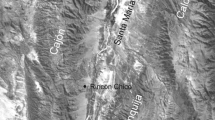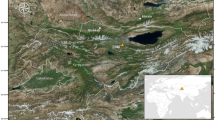Abstract
Weed assemblages from late medieval cornfields have been studied for the first time in northern Switzerland. Eleven samples from at least two different grain stores were investigated. The samples were collected from the carbonised remains of six wooden houses built in the late 13th century A.D. and which burnt down in the middle of the 15th century. The weed floras found in the spelt (Triticum spelta) and oats (Avena sativa) indicate a high botanical diversity in the cornfields at harvest time. Although oats are normally a summer crop and spelt a winter crop, both summer and winter crop weeds (as well as many different present-day grassland taxa) were found in each type of grain. Most of the weeds found were perennial plants, which was interpreted as an indication of both extensive tillage of the arable land and application of the three-field rotation system (Dreifelderwirtschaft). The spectra of the two palaeophytocoenoses (assemblages of ancient plant remains) studied suggest that the phytosociological method may not be reliable for classification of the late medieval remains into “summer” and “winter” crop weed communities. These findings should provide a better understanding of the development of anthropogenic plant communities, and in particular, the development of crop weed communities.
Similar content being viewed by others
References
Abel W (1978) Geschichte der deutschen Landwirtschaft vom frühen Mittelalter bis zum 19. Jahrhundert. Ulmer, Stuttgart
Behre KE (1976) Die Pflanzenreste aus der frühgeschichtlichen Wurt Elisenhof. Lang, Frankfurt/M
Behre KE (1981) The interpretation of anthropogenic indicators in pollen diagrams. Pollen Spores 23: 225–245
Behre KE, Jacomet S (1991) The ecological interpretation of archaeobotanical data. In: Zeist W van, Casparie WA (eds) Plants and ancient man. Studies in palaeoethnobotany. Balkema, Rotterdam, pp 81–108
Brun-Hool J (1963) Ackerunkraut-Gesellschaften der Nordwest-Schweiz. Huber, Bern
Ellenberg H (1982) Vegetation Mitteleuropas mit den Alpen in ökologischer Sicht. Ulmer, Stuttgart
Ellenberg H, Weber HE, Düll R, Wirth V (1991) Indicator values of plants in Central Europe. Scripta Geobotanica 18. Goltze, Göttingen
Gutscher D (1992) Laufen BE, Rathausplatz. Archäol Kanton Bern 2a: 139–140
Hildebrandt H (1980) Studien zum Zelgenproblem. Mainz Geogr Stud 14, Mainz
Hofmeister H, Garve E (1986) Lebensraum Acker. Pflanzen der Äcker und ihre Ökologie. Parey, Hamburg
Hüppe J (1987) Zur Entwicklung der Ackerunkrautvegetation seit dem Neolithikum. Natur Landschaftskunde 23: 25–33
Hüppe J, Hofmeister H (1990) Syntaxonomische Fassung und Übersicht über die Ackerunkrautgesellschaften der Bundesrepublik Deutschland. Ber Reinhold Tüxen-Gesell 2: 61–81
Jacomet S, Brombacher C, Dick M (1989) Archäobotanik am Zürichsee. Ackerbau, Sammelwirtschaft und Umwelt von neolithischen und bronzezeitlichen Seeufersiedlungen im Raum Zürich. Füssli, Zürich
Jacomet S et al. (in press) Samen und Früchte aus vorrömischen, römerzeitlichen und mittelalterlichen Ablagerungen aus der Altstadt von Solothurn (Schweiz), Areale von “Vigier” und “Klosterplatz”.
Jänichen H (1970) Beiträge zur Wirtschaftsgeschichte des Schwäbischen Dorfes. Veröff Kom Geschicht Landeskde Baden-Württemberg, Reihe B, 60, Kohlhammer, Stuttgart
Jones G (1984) Interpretation of archaeological plant remains: Ethnographic models from Greece. In: Zeist W van, Casparie WA (eds) Plants and ancient man. Studies in palaeoethnobotany, Balkema, Rotterdam, pp 43–61
Karg S (1991) Knoblauchzehen aus dem mittelalterlichen Laufen, BE. Archäol Schweiz 14: 257–260
Karg S (1993) Saatguthandel in prähistorischer und historischer Zeit. Ethnogr Archäol Z 34: 223–230
Karg S (1994) Pflanzliche Diversität im Mittelalter: Rekonstruktion einer spätmittelalterlichen Ackerflora bei Laufen (Schweiz) mit Hilfe von verkohlten Kulturpflanzenvorräten. Dissertation, Universität Basel
Körber-Grohne U (1967) Geobotanische Untersuchungen auf der Feddersen Wierde. Steiner, Wiesbaden
Körber-Grohne U (1990) Gramineen und Grünlandvegetationen vom Neolithikum bis zum Mittelalter in Mitteleuropa. Bibl Bot 139. Schweizerbart, Stuttgart
Lange E, Illig H (1990) Paläo-Ethnobotanische Befunde aus dem Feldflorareservat bei Luckau-Freesdorf/Niederlausitz. In: Experimentelle Archäologie in Deutschland. Archäol Mitt Nordwestdeutschland, Beiheft 4: 143–148
Oberdorfer E (1983) Pflanzensoziologische Exkursionsflora. Ulmer, Stuttgart
Pfrommer J (1993) Die spätmittelalterliche Besiedlung auf dem Areal des Rathausplatzes in Laufen (Schweiz) am Beispiel der Häuser H 5 und H 6. Magisterarbeit, Universität Tübingen
Pott R (1992a) Die Pflanzengesellschaften Deutschlands. Ulmer, Stuttgart
Pott R (1992b) Entwicklung von Pflanzengesellschaften durch Ackerbau und Grünlandnutzung. Gartenbauwissenschaft 57 (4): 157–166
Rachoud-Schneider AM (1993) Contribution à l'histoire de la végétation tardiglaciaire de la vallée de Delémont à partir de la palynologie. In: Guélat M, Rachoud-Schneider AM, Eschenlohr L, Paupe P (eds) Evolution d'un paysage jurassien depuis le tardiglaciaire. Cah archéol jurassienne 4: 53–74
Rösch M, Schmid B (1992) Ein hochmittelalterliches Grubenhaus mit verkohltem Kulturpflanzenvorrat von Biberach an der Riß. Fund Baden-Württemberg 17: 521–573
Rösch M, Jacomet S, Karg S (1992) The history of cereals in the region of the former Duchy of Swabia (Herzogtum Schwaben) from the Roman to the Post-medieval period: results of archaeobotanical research. Veget Hist Archaeobot 1: 193–231
Willerding U (1970) Vor- und frühgeschichtliche Kulturpflanzenfunde in Mitteleuropa. Neue Ausgrab Forsch Niedersachsen 5: 287–375
Willerding U (1979) Paläoethnobotanische Untersuchungen über die Entwicklung von Pflanzengesellschaften. In: Tüxen R (ed) Werden und Vergehen von Pflanzengesellschaften. Berichte der Internationalen Symposien der Internationalen Vereinigung für Vegetationskunde, Cramer, Vaduz, pp 61–109
Wilmanns O (1993) Ökologische Pflanzensoziologie. Quelle & Meyer, Heidelberg
Wilson DG (1984) The carbonisation of weed seeds and their representation in macrofossil assemblages. In: Zeist W van, Casparie WA (eds) Plants and ancient man. Studies in palaeoethnobotany, Balkema, Rotterdam, pp 201–206
Zoller H (1954) Die Typen der Bromus erectus-Wiesen des Schweizer Juras. Veröff Geobot Inst Eidg Tech Hochsch Stift Rübel Zürich 28
Author information
Authors and Affiliations
Rights and permissions
About this article
Cite this article
Karg, S. Plant diversity in late medieval cornfields of northern Switzerland. Veget Hist Archaebot 4, 41–50 (1995). https://doi.org/10.1007/BF00198614
Received:
Accepted:
Issue Date:
DOI: https://doi.org/10.1007/BF00198614




